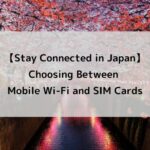The Ultimate Guide to Exploring Japan: Timing, Tickets, and Tips
2024-04-13
Embarking on a journey to Japan, a land of endless discovery where ancient traditions and modern marvels blend seamlessly, can be as daunting as it is exciting. Whether you’re drawn to the serene cherry blossoms of spring or the vibrant festivals of summer, navigating the intricacies of travel planning is crucial. This guide offers a comprehensive look at the optimal times to visit, uncovers the secrets to snagging the best flight deals, and provides essential tips to enhance your travel experience. From securing the perfect itinerary to exploring Japan’s rich cultural tapestry and technological hubs, you’ll find everything needed to make your trip not just a possibility, but a profound adventure. By following these insights, you’ll be able to immerse yourself fully in the unique rhythm of Japanese life and landscapes, making your travel both memorable and magical. Discover the joys of Japanese cuisine, the efficiency of its transport systems, and the hidden gems that await in both bustling cities and tranquil countryside. Get ready to explore Japan with confidence and curiosity!
In conclusion, to ensure a memorable and enriching trip to Japan:
- Plan Ahead: Time your visit to match seasonal events like cherry blossoms or festivals.
- Secure the Best Flights: Utilize comparison tools for the best rates.
- Respect Local Customs: Familiarize yourself with Japanese etiquette.
- Use Public Transport: Take advantage of Japan’s efficient transit systems.
- Dive into the Culture: Explore local cuisine and historical sites.
- Be Prepared: Obtain travel insurance and prepare for any contingencies.
By embracing these tips, you can fully enjoy the unique blend of tradition and modernity that Japan offers.
Introduction
Japan, a land where ancient traditions blend seamlessly with the forefront of technological innovation, offers an unparalleled destination for travelers. However, embarking on this journey requires meticulous planning, particularly in selecting the optimal time for a visit and securing the best flight deals. This introduction sets the stage for a comprehensive guide aimed at navigating these initial hurdles, ensuring travelers can fully immerse themselves in Japan’s vibrant culture, breathtaking landscapes, and cutting-edge urban environments. From the fleeting beauty of cherry blossoms to the bustling streets of Tokyo’s Akihabara, this article will guide you through planning the perfect Japanese adventure, striking a balance between cost, comfort, and timing. Whether drawn to the wilds of Hokkaido or the ancient allure of Kyoto, understanding when to go and how to get there affordably marks the first step toward a journey that promises to be unforgettable.
Best Times to Visit Japan

Each season in Japan offers distinct experiences that cater to different interests, from viewing cherry blossoms in spring to celebrating snow festivals in winter.
Seasonal Highlights in Japan
Spring (March to May): The allure of cherry blossoms, or sakura, makes spring perhaps the most iconic season to visit Japan. Tokyo, Kyoto, and Hirosaki are among the best places to enjoy hanami, the cherry blossom viewing parties. The weather during spring is comfortably mild, perfect for exploring cities and the countryside alike.
Summer (June to August): Summer is festival season across Japan, with vibrant celebrations like Tokyo’s Sumida River Fireworks and Osaka’s Tenjin Matsuri. Despite the humidity and the rainy season in early summer, this period offers a lively cultural experience with numerous matsuri (festivals) and fireworks displays.
Autumn (September to November): Autumn ushers in spectacular foliage transformations, with vibrant reds and golds adorning the landscapes. Kyoto and Nikko are famous for their koyo (autumn leaves) viewing spots. The cooler temperatures make it ideal for visiting temples and hiking in Japan’s mountains.
Winter (December to February): Winter in Japan is a wonderland of snow, especially in Hokkaido with its renowned Sapporo Snow Festival. Onsen (hot springs) are particularly enjoyable during this season, offering a warming experience in a picturesque snowy setting. The Japanese Alps are perfect for skiing and snowboarding enthusiasts.
Considerations for Travel Timing
Weather Conditions: Japan’s varied climate means weather conditions can greatly influence your experience. The rainy season (June to mid-July) often brings daily showers, affecting outdoor activities, whereas typhoon season (late August to October) can impact travel plans with stronger storms.
Festival Dates: Planning around festival dates can enhance your travel experience. For instance, catching the Gion Matsuri in July in Kyoto or the Sapporo Snow Festival in February offers a glimpse into Japan’s rich traditions and celebratory customs.
Peak and Off-Peak Travel Seasons: Peak travel times generally include the cherry blossom season (late March to April), Golden Week (late April to early May), and the New Year holiday (late December to early January). Flights and accommodation during these periods are typically more expensive and harder to book due to high domestic and international tourist turnout. Visiting during shoulder seasons, like early March or late November, can result in fewer crowds and lower prices.
Finding the Best Flight Deals to Japan

Securing the best deals on flights to Japan requires timing and strategy.
When to Book Your Flight
Typically, booking 2-3 months in advance can secure more favorable prices, especially if traveling during peak seasons. Monitor flight prices early to gauge trends and jump on deals when they occur.
Early Booking Advantages: Airlines often offer lower prices as a way to start filling planes early. By securing your seat months ahead, you not only save money but also get better choices of seating.
Last-Minute Deals: While sometimes riskier, last-minute bookings can offer significant savings, especially if airlines have many unsold seats as the flight date approaches. This is more common during off-peak seasons.
Tools and Tips for Booking Flights
Flight Comparison Websites: Tools like Skyscanner, Google Flights, and Kayak allow travelers to compare prices across multiple airlines and booking platforms, ensuring they find the lowest possible rates.
Alerts for Price Drops: Many of these websites offer alerts that notify you when prices drop for your specified routes and dates. Setting up alerts can take the stress out of constantly monitoring prices.
Flexible Dates and Airports: If possible, having flexible travel dates can lead to substantial savings. Flying mid-week or during less popular hours can reduce costs. Similarly, consider different airports, as some may offer cheaper routes or promotions that others don’t.
Budget Airlines vs. Major Carriers
Pros and Cons: Budget airlines like Peach Aviation or Jetstar Japan often provide significantly cheaper tickets compared to major carriers. However, these tickets usually come with strict baggage restrictions and no free in-flight services.
Hidden Costs to Watch Out For: While initial prices may be lower, additional fees for checked bags, seat selection, and even onboard meals can add up quickly. Always compare the total cost of your journey, not just the ticket price.
Planning Your Arrival in Japan
This introduction helps travelers decide on the best entry point into Japan based on their interests, whether they are drawn to the high-tech landscapes, culinary adventures, or natural beauty of the country. Each city offers unique experiences that can set the tone for your entire trip.
Choosing Your Arrival City
Tokyo: Gateway to Technology and Tradition
Tokyo, Japan’s bustling capital, is often the primary gateway for international travelers. Featuring two major airports, Narita and Haneda, Tokyo offers various options for inbound flights from all over the world. The city is a hub of innovation, home to the famous Akihabara electronics district, and steeped in tradition with sites like the Meiji Shrine and Asakusa’s Senso-ji Temple.
Osaka: A Culinary Heaven
Osaka is another popular entry point for visitors, especially those flying into Kansai International Airport. Known as Japan’s kitchen, Osaka is famed for its vibrant food scene, including local delicacies like takoyaki and okonomiyaki. The city also provides convenient access to historical Kyoto and the bustling port city of Kobe.
Hokkaido: Nature’s Paradise
For nature lovers, arriving in Hokkaido offers immediate immersion into Japan’s wild beauty. New Chitose Airport serves as the main gateway to this northern island, known for its dramatic landscapes, ski resorts, and the annual Sapporo Snow Festival. The region’s natural onsens provide a perfect remedy for jetlag.
From the Airport to the City
Transportation Options Upon landing in Japan, you have multiple options to reach your final destination comfortably and efficiently:
Trains: Japan’s rail network is world-renowned for its efficiency and coverage, with extensive services connecting airports to central cities and beyond. For example, the Narita Express (N’EX) directly connects Narita Airport with major Tokyo stations.
Buses: Airport limousine buses are a cost-effective and convenient way to get from the airport to various hotels and landmarks in the city.
Taxis: While more expensive, taxis offer direct and private transportation from the airport to your accommodation. They are particularly useful if you have heavy luggage or arrive late at night.
Rental Cars: Available at most airports, rental cars give you flexibility, especially useful in rural areas or for visitors planning extensive travel outside big cities.
Tips for Navigating Japanese Public Transport
IC Cards: Purchase an IC card such as Suica or Pasmo for convenient tap-and-go travel on public transit across Tokyo, Osaka, and other urban areas. These cards can be reloaded at convenience stores and stations.
Language Barrier: While major signs and announcements are in English, navigating the public transport system can still be daunting. Download translation apps and carry a phrasebook to ease communication.
Luggage: Be aware of luggage rules on public transport. Trains and buses in Japan have specific luggage compartments and restrictions, especially during rush hour.
Maximizing Your Travel Experience

By following these tips, you can maximize your travel experience in Japan, making it smooth, culturally enriching, and enjoyable. Whether it’s through culinary discoveries, efficient travel logistics, or cultural immersion, Japan offers a profound journey for every traveler.
Cultural Etiquette
Do’s and Don’ts in Japan: Understanding and respecting Japanese customs can significantly enhance your travel experience. Here are some essential etiquette tips:
Do bow when greeting others. A nod of the head or a slight bow is customary.
Do not tip. Tipping is not a part of Japanese culture and can be seen as offensive.
Do be punctual if you have appointments or reservations.
Do not eat or drink while walking; it’s considered rude.
Do be quiet on public transport. It’s polite to set your phone to silent and avoid loud conversations.
Do take off your shoes when entering someone’s home or certain traditional accommodations like ryokans.
Travel Insurance
Why It’s Essential for Japan: Japan is a safe country for travelers, but having travel insurance is crucial as unexpected events, from health issues to lost luggage, can happen. Japanese healthcare is excellent but expensive for tourists. Travel insurance that covers health, emergency transport, theft, and cancellations is highly recommended to safeguard your journey.
Staying Connected
SIM Cards and Pocket Wi-Fi in Japan: Staying connected is vital for navigating, translations, and keeping in touch with friends and family. Here’s how:
- SIM Cards: You can purchase a local SIM card at the airport or online before you travel. These offer a range of data plans tailored to short and long visits.
- Pocket Wi-Fi: Renting a pocket Wi-Fi device is a popular option. It provides unlimited internet access wherever you go, which is perfect for travelers who need to connect multiple devices or share connectivity with travel companions.
Navigating Japanese Cuisine
Embracing Local Food: Japanese cuisine is diverse and regionally distinct. Here are a few tips to enjoy Japan’s culinary offerings fully:
- Try local specialties: Each region has its specialties, from Hokkaido’s fresh seafood to Kyoto’s kaiseki and Osaka’s street food.
- Use chopsticks properly: Avoid sticking them vertically into bowls of rice or passing food directly from one pair of chopsticks to another.
- Explore beyond sushi: Japan’s culinary world extends far beyond sushi and ramen. Don’t miss out on other dishes like yakitori, okonomiyaki, and tempura.
Managing Finances
Cash and Payments in Japan: While Japan is gradually becoming more card-friendly, cash is still king in many places, especially in rural areas or at small eateries and temples.
- Carry sufficient cash: Ensure you have enough yen to cover places that don’t accept cards.
- Use international ATMs: International ATMs are widely available at convenience stores like 7-Eleven and post offices, which accept foreign cards for cash withdrawals.
Conclusion
As you prepare for your journey to Japan, remember that the key to a fulfilling trip lies in careful planning and a willingness to embrace the local culture. From choosing the best time to visit based on seasonal attractions and festival dates, to selecting the right flight and navigating airport transfers efficiently, each step offers its own set of opportunities and challenges.
Utilizing tools like flight comparison websites and alerts for price drops can significantly ease the process of booking flights, while understanding public transport systems and cultural etiquette can enhance your experience once you arrive. Moreover, staying connected through options like SIM cards or pocket Wi-Fi will help you navigate the country with ease, and embracing the local cuisine will undoubtedly enrich your visit.
Ultimately, Japan offers a unique blend of the ancient and the modern, the natural and the crafted, which you can enjoy thoroughly with the right preparation. By planning strategically and respecting local customs and practices, you will not only save money but also gain deeper insights and more meaningful interactions during your stay. This guide aims to equip you with the knowledge to make the most of your travels, ensuring that your experience in Japan is nothing short of spectacular. Whether it’s your first visit or a return journey, Japan will always have new wonders to explore and experiences to offer.


 Language
Language














